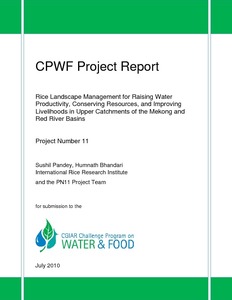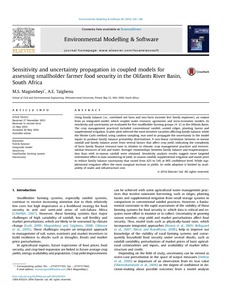Rice landscape management for raising water productivity, conserving resources, and improving livelihoods, in upper catchments of the Mekong and Red River basins
The project validated and disseminated a large number of improved rice-based cropping systems technologies suited to upland agro-ecologies. These improved technologies have good potentials to raise the productivity of water, land, and labor. The innovative strategies employed by the project including the paradigm of landscape management, multi-institutional partnership, multidisciplinary teamwork, farmer participatory approach to technology validation, and community-based seed production led to successful generation and dissemination of technologies.
Secondary forests in swidden agriculture inthe highlands of Thailand
Swidden farming is the main agent of conversion of primary forests to secondary forests in the highlands of mainland Southeast Asia, but there is a deterioration and decline of the practice with land use intensification. The population growth in northern Thailand has forced lowland farmers practising permanent wet rice cultivation to turn to short rotation swidden in the foot hill zone. Highland swidden agriculturists are adopting more intensive forms of swidden or are shifting to permanent farming.
Secondary forests in the lower Mekong subregion: an overview of their extent, roles and importance
Much of mainland Southeast Asia's primary forest has been converted into secondary vegetation types in the past several decades. In the Lower Mekong Subregion, nearly 100 million ha of forest were significantly altered or removed, with depletion in terms of areal percent most severe in Thailand and Vietnam. Timber extraction and conversion of forestland to agriculture are the two principal causes of forest degradation in the region. Logged sites are often later occupied by migrant homesteaders. The current regional focus of logging has shifted to Laos, Cambodia and Myanmar.
Securing water through land: Field findings on water reform and water reallocation in South Africa: Trichardtsdal Ofcolaco and Leydsdorp
Savannas program : Biennial report 1992-1993
Self-governance and forest resources
Forest resources share attributes with many other resource systems that make difficult their governance and management in a sustainable, efficient and equitable manner. Destruction or degradation of forest resources is most likely to occur in open-access forests where those involved, or external authorities, have not established effective governance. Conventional theories applied to forest resources presumed that forest users themselves were incapable of organizing to overcome the temptations to overharvest.
Scaling up Sustainable Agriculture Land Management in Bungoma County, Kenya
Agricultural landscapes must provide food, fiber and energy to
a growing population in a changing climate, while potentially
serving as instruments for climate change mitigation. Agriculture
is the backbone of the Kenyan economy, contributing approximately
25% of the GDP annually and employing more than 75%
of the population (The Government of Kenya 2010). The development
of agriculture is also important for poverty reduction since
most of the vulnerable groups, like pastoralists, the landless, and
Sensitivity and uncertainty propagation in coupled models for assessing smallholder farmer food security in the Olifants River Basins, South Africa
Using family balance (i.e., combined net farm and non-farm incomes less family expenses), an output from an integrated model, which couples water resource, agronomic and socio-economic models, its sensitivity and uncertainty are evaluated for five smallholder farming groups (AeE) in the Olifants Basin. The crop management practiced included conventional rainfed, untied ridges, planting basins and supplemental irrigation.
Second quarter progress report. Kirindi Oya Irrigation and Settlement Project: Project impact evaluation study
Secondary forest: a working definition and typology
With past and continued destruction of primary forest worldwide, secondary forest constitute a large and growing component of forest cover and have been found to be very important for a wide range of goods and services. Despite its widespread usage, there is considerable ambiguity with regard to the meaning of the term 'secondary forest' and the different forest types it encompasses.
Smallholder farmers’ attitudes and determinants of adaptation to climate risks in East Africa
Adapting to climate risks is central to the goal of increasing food security and enhancing resilience of farming systems in East Africa. We examined farmers’ attitudes and assessed determinants of adaptation using data from a random sample of 500 households in Borana, Ethiopia, Nyando, Kenya, Hoima Uganda, and Lushoto, Tanzania. Adaptation was measured using a livelihood-based index that assigned weights to different individual strategies based on their marginal contributions to a household’s livelihood.






